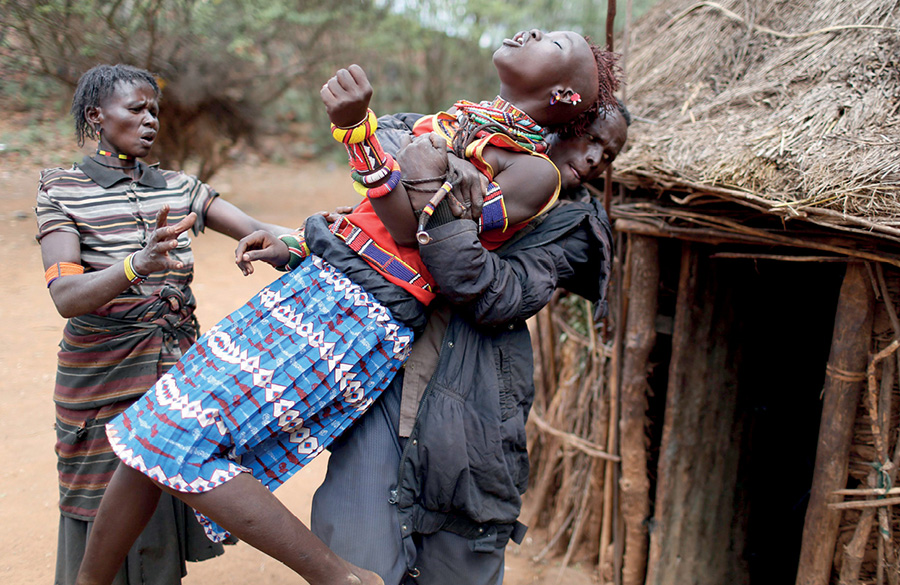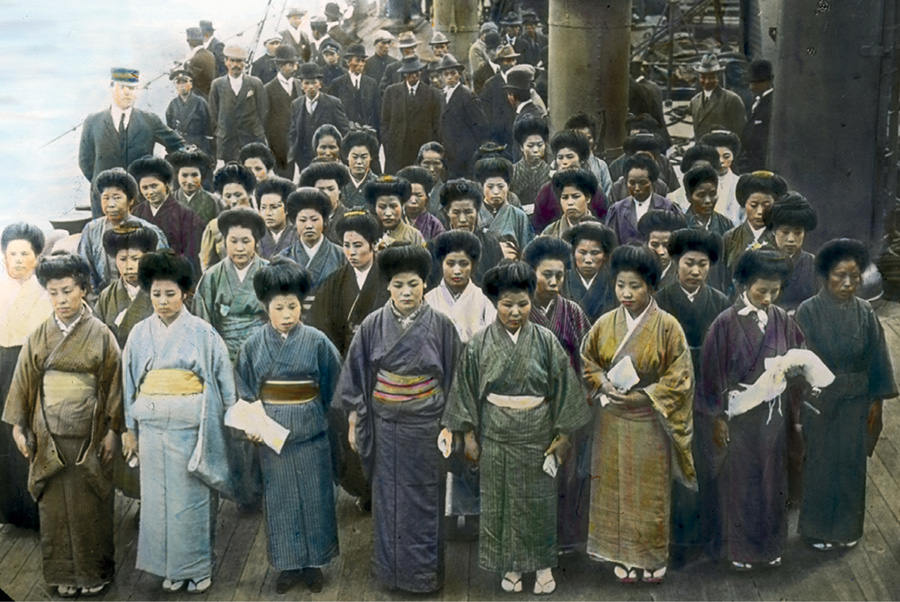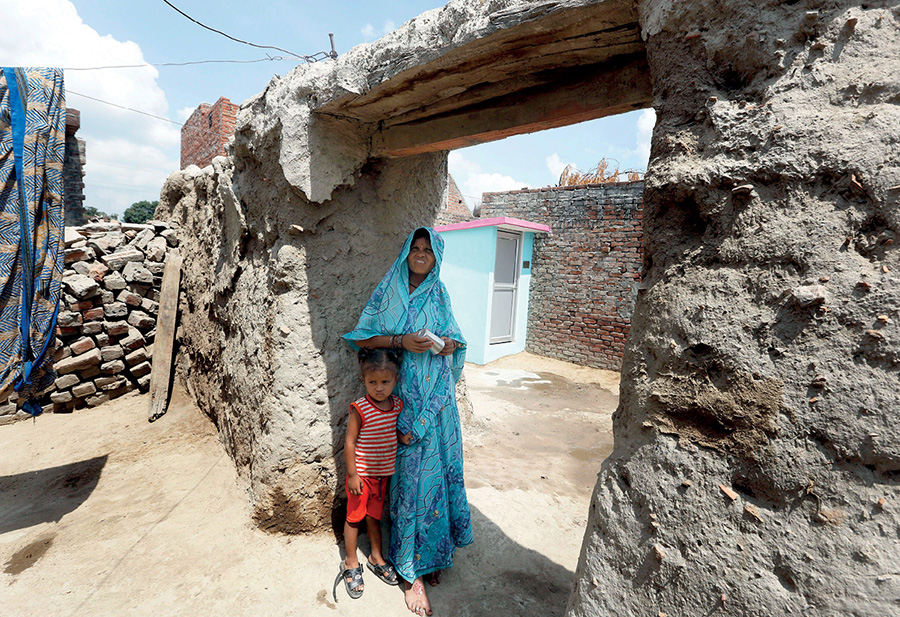4
Will You Marry Me?
When Romeo and Juliet fall in love at a masked ball, they know perfectly well that their families, sworn enemies, will never agree to the match. The play, written by William Shakespeare and published in 1597, is set in Verona, Italy, in the fourteenth century. Romeo doesn’t bother asking for Juliet’s hand. Instead, the young couple ignore all the usual customs of betrothal (engagement). They marry in secret, defying Juliet’s father, who has already arranged to marry her to a relative named Paris. Things do not go well.

In Europe during earlier centuries, young people were supposed to let their fathers choose their spouses. The fictional Romeo and Juliet, from William Shakespeare’s play of the same name, defied their families and married in secret. The photo shows Claire Danes and Leonardo DiCaprio playing the couple in a 1996 film version of the play.
A Perfect Match
In choosing spouses for their children, parents of earlier centuries wanted to achieve specific goals. A nobleman might want to cement a political alliance. A farmer might want a skilled baker as a daughter-in-law. Making a love match—or even a friendly match—was low on the list of priorities.
If parents couldn’t find a suitable match, they might turn to a professional matchmaker for help, a practice that occurred in many cultures—and still does in Asia, India, and elsewhere. For example, the Jews of eastern Europe, from the Middle Ages to the early twentieth century, used matchmakers to arrange marriages. In the 1964 US musical Fiddler on the Roof, which takes place in a Jewish village in Russia at the beginning of the twentieth century, the town matchmaker is tasked with finding husbands for the milkman’s daughters.
Chinese parents also employed matchmakers to identify promising mates, a practice that continues in the twenty-first century. Very wealthy Chinese families might hire high-end “love hunters,” paying from $50,000 to more than $1 million for their services. Chinese parents who can’t afford a matchmaker can turn to marriage markets held in city parks. There, parents hold signs detailing the physical and professional attributes of a young person looking to wed. This type of matchmaking isn’t very effective. One mother sat for four years and received only a handful of inquiries. None of them agreed to marry her son.
Five Goats and Ten Barrels of Wine
When parents and matchmakers were in charge of arranging marriages, the job didn’t end with identification of the perfect match. Instead, the two families began to negotiate financial aspects of the marriage transaction. Marriage was a business deal as well as a social arrangement. Families exchanged gifts and money to cement this relationship.
In most of Europe, from the Middle Ages to the nineteenth century, and in much of Asia, the Middle East, and Africa, from ancient times to the twenty-first century, the bride’s family made a payment of money or goods, called a dowry, to the prospective groom or his family. Parents paid dowries to ensure that a daughter began married life with some financial security. The money or goods helped the newlyweds establish a home. Parents sometimes paid the dowry to a new son-in-law in installments. If he didn’t treat their daughter well, the husband couldn’t collect the rest of the assets.
The amount of money depended on the circumstances of the families involved. Marrying up—into a family with a higher social status—cost more than marrying into a less wealthy family. Since most societies did not value single women, parents needed to find husbands for their daughters. A girl’s physical attributes mattered. If she was unattractive, it could be hard to find her a husband, so the parents might offer a larger dowry to sweeten the deal for the groom and his family.
European dowry traditions declined in Europe’s North American colonies in the seventeenth century. The majority of the colonists were men who set out alone to make a new life in the New World. They wanted wives with whom to start families and households, but marriageable women were in short supply. Happy to find a wife at all, the men didn’t care whether a woman’s family had money to pay a dowry, so the dowry system began to fade. The practice of paying dowries continued in Europe until about World War I (1914–1918). After that, women began entering the workforce in larger numbers, and dowries were no longer necessary. In the twenty-first century, one throwback to the dowry tradition is the custom of the bride’s parents paying for the wedding. (Increasingly, however, families in the United States are splitting the cost of the wedding.)
In other parts of the world, dowry traditions varied by culture. In ancient Hindu marriages, the bride’s dowry consisted of elaborate jewelry and other valuables. These assets would give her some financial security if her husband died. In other cultures, the payment went from the groom or the groom’s family to the bride’s family. The payment was meant to compensate the bride’s family for the loss of their daughter’s labor. Cash, livestock, property, fabrics, or alcohol could all be part of the required payment, called a bride-price, or tribute. This practice was widespread—from Egypt and Mesopotamia in the ancient world to the Aztecs of Mexico and Incas of South America in the centuries before European conquest.

This nineteenth-century watercolor illustration shows an Indian bride bedecked in jewelry. In the Hindu tradition, a bride’s jewelry served as her dowry—a gift from her family to the groom.
In the twenty-first century, the dowry tradition continues in parts of the Middle East, South Asia, and central Asia. The bride-price tradition continues in parts of China, Taiwan, Thailand, Turkey, and many countries in Africa. In Somalia, a Muslim nation, marriages include both a dowry and a bride-price. In earlier eras, the groom’s family paid a bride-price in camels, but in the twenty-first century, the gift is in cash.
Betrothed as Babies
In twelfth-century Europe, fathers often married off their daughters before the girls reached puberty (reproductive age). They were often married to men who were much older. Men wanted wives who were virgins, and the younger the bride, the more likely she was to be without sexual experience. Pope Alexander III, head of the Catholic Church from 1159 to 1181, didn’t think that children should be married. He issued a decree stating that the minimum age for marriage should be twelve for girls and fourteen for boys. Many parents, eager to marry off their daughters to cement family alliances, ignored the ruling.
The Chinese practice of t’ung yang-hsi, which lasted into the twentieth century, involved arranging the marriage of a baby girl. The baby was then formally given to her future husband’s family, who raised her. At some points in Chinese history, this custom accounted for about 20 percent of marriages. Often the bride and groom were relatively close in age, but sometimes, as in Europe, parents arranged legal marriages between very young girls and much older men. A similar practice occurred in India in earlier centuries, but in that culture, the young bride stayed with her own family until she reached puberty and then she moved in with her husband’s family.
Many people in the United States view child marriage as a relic of the past. This is not the case. Between 2000 and 2010, nearly 250,000 American girls under the age of eighteen got married. Some were as young as twelve. Of those girls, 31 percent married men older than twenty-one. The nonprofit group Unchained at Last has documented child marriage in nearly all American cultural and religious groups.
Around the world, thirty-nine thousand girls under the age of eighteen are forced into marriage every single day. That’s almost fourteen million girls each year. Many of them are under the age of fifteen. Often their families have arranged for their marriages to much older men. Parents who choose such matches are often poor and can’t afford to adequately support or educate their daughters. Pressured by their families and communities, the brides must accept the marriages. The vast majority of these girls live in India. Child marriage is also common in many parts of Southeast Asia and Africa. Teenager Zulie, from Ghana, writes about her younger sister: “I’m telling you my sister’s story because it’s something that I’ve been worried about. Her favorite subject is math. She was 14 years old when a man came to see my father. He offered my father cola nuts and 60 cedis ($40) to marry my sister. My father agreed because he doesn’t have the money to send us to school. Now [instead of going to school] my sister just sits and waits for the day she’s going to marry.”

In this photo from 2014, a man holds a teenage girl in Kenya as she struggles to break free. She has just learned that she is to be married to a man she doesn’t know in a distant town. Her family arranged the marriage, and the groom provided a bride-price of twenty goats, three camels, and ten cows.
For child brides, the dangers and the repercussions are serious. Many experience violence and abuse at the hands of their husbands. And early marriage means the end of education and the beginning of decades of childbirth and motherhood. Around the world, every hour, girls between the ages of fifteen and nineteen give birth to about sixteen hundred babies. Pregnancy and childbirth are the leading causes of death for girls in this age range. They die because they live mostly in poor nations, where prenatal care is often nonexistent or inadequate. Birthing facilities are barebones and unsanitary. Many girls are already in poor health—suffering from HIV/AIDS or undernourishment—when they become pregnant. Without education and health care, these teen mothers and their children are trapped in poverty. The likelihood of making a better life is extremely low. The United Nations (UN)—an international humanitarian and peacekeeping organization—considers the forced marriage of girls and women to be a form of slavery. The UN works with global nonprofit organizations to address the poverty and social conventions that lead to forced marriage.
The Short List
Arranged marriages, unlike forced child marriages, can be a positive. According to Hindu and Islamic traditions, true marriage is defined as a mutually agreed-upon relationship. In a Muslim wedding ceremony, the cleric (religious official) asks the bride three times whether she is marrying of her own free will. Brides answer yes because they trust that their parents have their best interests at heart and have matched them with an honorable husband.
The marriage of Sai Srinivasan and Uma Viswanathan, who are both Hindus from India, is an example of a successful arranged marriage. In seeking a spouse, both wanted matchmaking help from their families. They also wanted to have some say in the matter.
In 1999, when Srinivasan was in his twenties and living in Chicago, Illinois, he asked his family in India to look for a wife for him back home. They placed an ad in an Indian newsletter designed to introduce bachelors to prospective brides. Viswanathan and her family, who were also in India, did something similar. From responses to the ads, both sets of parents then created lists of potential spouses and presented them to their kids. Srinivasan caught Viswanathan’s interest. Her brother, who was living in California, flew to Chicago to meet Srinivasan and then arranged a phone call between the couple. Eventually their families in India met in person, and Srinivasan flew to India to meet her. Both agreed to the match. They married in India, and she moved to Chicago with her new husband.
Like this couple, many young people are happy to accept their parents’ help in matchmaking. Arshi Mujtaba, a Muslim woman who was born in Pakistan, says of her arranged marriage, “I believe my parents made a good decision for me. If they had left it completely to me, I may not have made a good decision.”
On Bended Knee
The gentleman is nervous, or so the story goes. He’s agonized over this for weeks. Is this the right time? Is this place romantic enough? Is she the right one? He fumbles with the velvet box in his pocket. He watches her face. What if she says no?
Finally, he gathers his courage and kneels before her, holding out a sparkling ring. “Will you marry me?” This is it—the proposal!
Marriage-by-choice is the norm in most Western countries, and the proposal on bended knee is a classic but relatively new tradition. No one knows for sure where the tradition comes from. Some say it recalls the way a European knight traditionally knelt before his queen in a show of loyalty. Others say it recalls the kneeling position of prayer in some religions. Whatever the origin, the symbolism is clear—honoring the beloved and offering commitment.
Marriage proposals have taken myriad forms over the centuries. In an old English practice, if a young man gave his sweetheart a pair of gloves and if she wore them to church the next Sunday, they were engaged. In a Welsh tradition, a suitor presented a carved wooden spoon to the woman he wanted to marry. If she wore it on a ribbon around her neck, her answer was yes. In most cultures, the man proposes to the woman, but not always. A European folk custom encourages women to propose to men on February 29, or leap day, which comes once every four years. In developed nations, sometimes women propose to their male partner on whatever day they want. And when it comes to same-sex marriage proposals, either partner can pop the question.
Proposals can be simple, or they can be elaborate proclamations of love. In Portland, Oregon, Isaac Lamb choreographed a cast of sixty, including a marching band, in his lip-dub proposal to Amy Frankel. While she watched from the back of a car and listened on headphones to “Marry You” by Bruno Mars, the couple’s friends and family created an elaborate dance spectacle, which was filmed and posted on YouTube. More than thirty million people have viewed the video. You can search YouTube for “Isaac’s Live Lip-Dub Proposal” to see it yourself.
In Georgia, Matt Still went cinematic for his proposal to Ginny Joiner. He enlisted videographer Michael Escobar to make a movie trailer in which Matt asks Ginny’s dad for his daughter’s hand in marriage. The video depicts Matt racing to a movie theater to find Ginny. Ginny was sitting with her brother in the theater when Matt’s trailer came on the big screen. Then real-life Matt ran inside and proposed to her. She had no idea that she was being filmed the whole time or that the back of the theater was full of family and friends. (Search YouTube for “Greatest Marriage Proposal EVER!!!” to see how it happened.)

Some people go to extraordinary heights to propose marriage, sometimes spending thousands of dollars on the proposal.
Sometimes an outpouring of love can have surprising effects. When Lucas Bane proposed to David Devora in a song-and-dance extravaganza in West Hollywood, California (search Vimeo for “Lucas and David” to see it), he hoped David would say yes—and he did. What Lucas didn’t expect was to hear from a former high school classmate who had bullied him for being gay. The man wrote, “If you do remember me, it’s probably not positive. . . . I saw your video today on Facebook and wanted to say Congratulations! . . . What you have is awesome.” The man went on to apologize for being a jerk in high school. Lucas wrote back, “You’ve made me feel so validated and hopeful about where the world is headed. You’ve really given me a gift.”
And then there’s Greek banker Alexander Loucopoulos. He knew that his girlfriend, Guatemalan architect Graciela Asturias, was fascinated by outer space, so he booked a flight on a modified airplane that lets passengers experience zero gravity, the feeling of weightlessness that humans experience in space. Once they were floating in the plane, he pulled out an engagement ring and proposed. Asturias accepted. You might say the proposal was out of this world!


